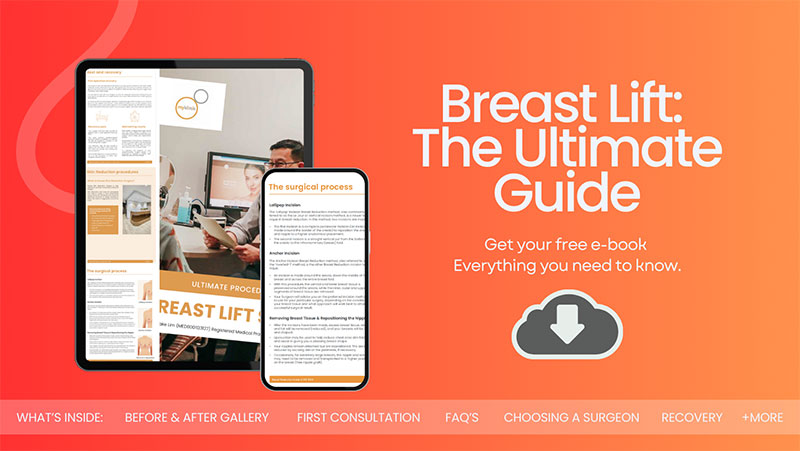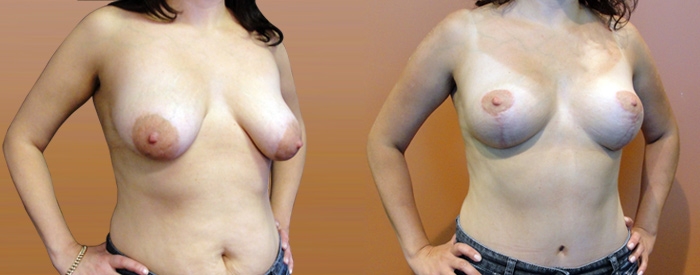What Is the Recovery After Breast Lift Surgery?
If you’re planning to have this surgery, or have recently undergone the procedure, understanding what comes next is key to a smooth, stress-free healing process. Known in medical terms as ‘mastopexy’, this operation involves the removal of excess skin and tightening of surrounding tissue, altering the contour and elevation of the breasts. However, the journey doesn’t end in the operating room; in fact, it’s just the beginning. The period after your surgery, known as the post-operative phase, is essential to the success of the procedure. It’s not only about how well your wounds heal, but also how you adjust to the changes in your body while maintaining a positive and patient mindset. You might face discomfort, swelling, and preparing for these is an important step toward a successful recovery.
Sydney Plastic Surgeon Dr Jake Lim has dedicated many years to cosmetic surgery. His extensive experience encompasses a variety of breast procedures, including breast lift (also known as mastopexy).
Dr Lim’s 2024 Breast Lift Guide

What to Expect in the First Week after Breast Lift
This phase is about taking it easy, understanding the changes happening in your body, and following professional advice to make every effort to ensure a smooth recovery. Let’s break down what you’ll experience during this immediate recovery phase:
· The First 24 Hours
Once your surgery is completed, you’ll find yourself in the recovery room where medical staff will closely monitor you as the anaesthesia wears off. It’s common to feel groggy, tired, or even a bit confused. This is completely normal, and during this time, you may also experience some discomfort, tightness, and pain around your chest area. Remember to communicate your pain level to the recovery team so it can be managed effectively with medication.
Some swelling and bruising are to be expected, and you might have bandages and drains in place. It’s essential to follow Dr Lim’s advice on how to move, how often to change your dressings, and managing the drains. You might feel a bit foggy — a side effect of the anaesthesia — but this will clear gradually. By the end of the first day, you’ll have a clearer head as you rest and let your body start the healing process.
· Days 2 to 7
The days following your surgery will be a mix of rest, small activities, and follow-up care. Here’s a general guide of what might happen, though remember everyone’s experience can vary:
- Day 2-3: You may notice the swelling and bruising reach their peak before starting to subside. Pain should be manageable with medications, and you’ll need to continue with rest, minimal movement, and care for the incision sites
- Day 4-5: As you become more alert, you might feel impatient or even a bit low. It’s normal to have a range of emotions after surgery — from joy at having completed it to anxiety about the outcomes. Remember, healing takes time, and the initial appearance post-surgery is not the final result
- Day 6-7: You may be regaining mobility, but it’s essential to avoid any straining, lifting, or vigorous activity. You’ll likely see improvements in bruising and swelling and get a glimpse of your surgery’s results, but remember the tissues need more time to settle

Sutures, Drains, and Follow-up Appointments
Within the first week or two, you’ll have your first post-op appointment. This visit is essential as Dr Jake Lim will check your incisions, possibly remove drains, if you have them, and ensure your recovery is on track. They may change your bandages and provide guidance on caring for the incision lines.
Understanding and maintaining drain care is also important, as drains help prevent fluid build-up in the operated area. You’ll learn how to empty and clean the drains at home, and Dr Lim will advise you when to come into the practice so they can be removed — typically, once the output meets specific criteria.
The initial week post-surgery is a delicate time and following Dr Lim’s guidelines is key. Take care of your sutures, monitor your drains, and above all, allow your body the time it genuinely needs to start healing properly.
Weeks 2 to 6 after Breast Lift Surgery
As you move past the initial recovery phase after your breast lift surgery, the journey isn’t over yet. The following weeks are vital as your body continues to heal beneath the surface, and your emotional well-being evolves with the physical changes. During these weeks, you’ll notice more evident changes. Swelling reduces, incisions start to heal, and the shape of your breasts becomes more defined. However, remember that internal healing is still ongoing. It’s not uncommon to feel stiffness, especially in the morning, or experience itching around the healing tissue and incision areas. These sensations are a standard part of recovery, signalling that your body is working to repair itself.
This period may also bring unexpected feelings or issues. You might encounter days where discomfort flares slightly or sensations in your breasts change. Stay in touch with your medical team during these times to confirm what’s normal and what requires attention.
The Role of Nutrition and Physical Activity in Healing
Nutrition significantly influences healing. In these weeks, focus on foods known to support tissue repair and reduce inflammation. Vitamin C-rich foods like oranges, strawberries, and capsicums can aid collagen production, vital for healing skin. Zinc is also important, found in foods like beans, nuts, and animal proteins, contributing to tissue strength and repair.
Adding anti-inflammatory foods such as leafy greens, cherries, and fatty fish, and staying well-hydrated assists in reducing swelling and flushing out toxins. Meanwhile, limiting high-sodium foods, processed items, and excessive sugar helps prevent unnecessary fluid retention and inflammation.
In terms of physical activity, it’s essential to reintroduce exercise cautiously. While you should avoid strenuous activities, gentle walks can promote blood circulation, and limited simple stretching can help ease stiffness. Always follow the specific guidance provided by Dr Lim before resuming any exercise routine, ensuring your activities don’t hinder your healing process.
Long-term Care and Maintaining
After undergoing breast lift surgery, it’s important to remember that while the operation is over, maintaining the results requires ongoing commitment.
Minimising Surgical Scars
Scars are a natural part of surgery, and while they do fade over time, they never disappear completely. To reduce the appearance of scarring, there are several approaches you can take. Specialist silicone gels and sheets can be used to help flatten and lighten scars. Regular gentle massage of the area (once fully healed) can increase blood flow and aid in scar reduction. Additionally, treatments such as laser therapy are available; however, these should be discussed with your plastic surgeon to ensure they’re appropriate for your situation.
While minimising scars is one approach, accepting them is also an important part of your psychological recovery. Scars are reminders of the journey you’ve been through. They represent a decision you made for your own well-being and the changes you’ve experienced.
The Impact of Lifestyle on Longevity of Results
The results of your breast lift are not immune to the effects of lifestyle and natural processes. Eating a balanced diet and maintaining a steady weight can significantly impact the long-term appearance of your breast lift. Extreme weight fluctuations can stretch the skin and affect the shape of your breasts, diminishing the surgery’s initial impact.
Furthermore, life events like pregnancy and breastfeeding can also alter breast shape and volume. If you’re planning for a pregnancy, it’s worth discussing this with your plastic surgeon, as it may influence decisions about the timing of surgery or the specific techniques used.
Negative habits like smoking can affect skin quality and healing, potentially worsening scarring and skin condition. Positive habits, such as wearing supportive bras and practicing good posture, contribute to maintaining your results.
Ongoing health checks are key. Regular check-ups with your GP or a specialist, including routine mammograms, are essential for monitoring your breast health. These checks can help identify any changes, including those unrelated to your surgery, at an early stage when they are more easily managed.
FAQs about Recovery after Breast Lift Surgery

How long will it take for me to fully recover from a breast lift/Mastopexy surgery?
- Recovery can vary greatly among individuals. Generally, most people can resume non-strenuous activities within a week or two post-surgery. However, it might take several months for the breasts to settle into their new shape, and for scarring to start to fade. It’s important to follow Dr Lim’s advice and listen to your body to ensure you don’t rush your recovery.
What should I do if I notice an infection or unexpected changes in my breasts post-surgery?
- If you observe any signs of infection, including unusual swelling, redness, warmth, or discharge from the incision sites, or if you develop a fever, it’s essential to contact your plastic surgeon or healthcare provider immediately. Similarly, any sudden changes in breast shape, persistent pain, or any other concerns should prompt a quick consultation.
Can I still undergo mammograms after a breast lift?
- Yes, you can still have mammograms after a breast lift. It’s important to continue regular breast cancer screenings as recommended for your age group and medical history. Ensure that the mammogram technician is aware of your surgery, as this knowledge might affect the technique they use during the screening.
Will I need to have another breast lift if I get pregnant after the procedure?
- Pregnancy and breastfeeding can alter breast size and shape significantly due to hormonal changes, weight gain, and lactation. Some women find that their breasts don’t change much after childbirth, while others might experience significant alterations. Depending on these changes, some women opt for revision surgery after completing their families to restore the appearance of their breasts.
What are some tips for minimising scarring after the procedure?
- While some scarring is inevitable, there are several strategies to minimise their appearance. After the incisions have healed, you can apply silicone sheets or gels, which can help flatten and fade scars. Protecting scars from the sun, keeping them moisturised, and using gentle massage techniques can also promote better healing. Always follow your plastic surgeon’s specific advice for optimal results.
Further Reading about Breast Procedures with Dr Jake Lim
- Read Dr Lim’s Blog about Top Tips and Recommendations to Reduce Scars after Breast Lift Surgery
- Read Dr Lim’s Blog about Augmentation Mastopexy – Breast Lift with Implants
- Read Dr Lim’s Blog about Mastopexy – Breast Lift without Implants
- Read Dr Lim’s Blog about Reduction Mammoplasty – Breast Reduction
- See Dr Lim’s Breast Lift Photo Gallery
- Read Dr Lim’s Blog about What Can I Do To Optimise My Surgical Results
- Read Dr Lim’s Blog about Typical Emotions Experienced After Plastic Surgery
- Read Dr Lim’s Blog about Healthy Food and Supplements During The Post-Operative Period
- Read Dr Lim’s Blog about Will Medicare cover my Breast Lift?
- Read Dr Lim’s Blog about Exercise after Mastopexy – Tips and Timeline
- Read Dr Lim’s Blog about Pre-surgery Preparation Checklist for a Breast Lift (Mastopexy)
- Read Dr Lim’s Blog about Potential Breast lift Complications
- Read Dr Lim’s Blog about Breast Lift Surgery – Myths and Facts
- Read Dr Lim’s Blog about Breast Lift Techniques – Which One Is Right for You
- Read Dr Lim’s Blog about Getting the Best Outcome for Your Breast Lift (Mastopexy) Surgery
- Read Dr Lim’s Blog about Non-Surgical vs. Surgical Breast Lift (Mastopexy)
- Read Dr Lim’s Blog about Breast Lift – Mastopexy FAQs
Medical References about Breast Lift
- Breast Lift (Mastopexy): Surgery & Recovery – Cleveland Clinic
- Breast Lift – American Society of Plastic Surgeons
- Mastopexy (Breast Lift Surgery) – WebMD
- Breast Reshaping After Massive Weight Loss – PubMed




